Jack Merullo
$100K or 100 Days: Trade-offs when Pre-Training with Academic Resources
Oct 30, 2024Abstract:Pre-training is notoriously compute-intensive and academic researchers are notoriously under-resourced. It is, therefore, commonly assumed that academics can't pre-train models. In this paper, we seek to clarify this assumption. We first survey academic researchers to learn about their available compute and then empirically measure the time to replicate models on such resources. We introduce a benchmark to measure the time to pre-train models on given GPUs and also identify ideal settings for maximizing training speed. We run our benchmark on a range of models and academic GPUs, spending 2,000 GPU-hours on our experiments. Our results reveal a brighter picture for academic pre-training: for example, although Pythia-1B was originally trained on 64 GPUs for 3 days, we find it is also possible to replicate this model (with the same hyper-parameters) in 3x fewer GPU-days: i.e. on 4 GPUs in 18 days. We conclude with a cost-benefit analysis to help clarify the trade-offs between price and pre-training time. We believe our benchmark will help academic researchers conduct experiments that require training larger models on more data. We fully release our codebase at: https://github.com/apoorvkh/academic-pretraining.
Talking Heads: Understanding Inter-layer Communication in Transformer Language Models
Jun 13, 2024Abstract:Although it is known that transformer language models (LMs) pass features from early layers to later layers, it is not well understood how this information is represented and routed by the model. By analyzing particular mechanism LMs use to accomplish this, we find that it is also used to recall items from a list, and show that this mechanism can explain an otherwise arbitrary-seeming sensitivity of the model to the order of items in the prompt. Specifically, we find that models write into low-rank subspaces of the residual stream to represent features which are then read out by specific later layers, forming low-rank communication channels between layers. By decomposing attention head weight matrices with the Singular Value Decomposition (SVD), we find that previously described interactions between heads separated by one or more layers can be predicted via analysis of their weight matrices. We show that it is possible to manipulate the internal model representations as well as edit model weights based on the mechanism we discover in order to significantly improve performance on our synthetic Laundry List task, which requires recall from a list, often improving task accuracy by over 20%. Our analysis reveals a surprisingly intricate interpretable structure learned from language model pretraining, and helps us understand why sophisticated LMs sometimes fail in simple domains, facilitating future analysis of more complex behaviors.
Dual Process Learning: Controlling Use of In-Context vs. In-Weights Strategies with Weight Forgetting
May 28, 2024



Abstract:Language models have the ability to perform in-context learning (ICL), allowing them to flexibly adapt their behavior based on context. This contrasts with in-weights learning, where information is statically encoded in model parameters from iterated observations of the data. Despite this apparent ability to learn in-context, language models are known to struggle when faced with unseen or rarely seen tokens. Hence, we study $\textbf{structural in-context learning}$, which we define as the ability of a model to execute in-context learning on arbitrary tokens -- so called because the model must generalize on the basis of e.g. sentence structure or task structure, rather than semantic content encoded in token embeddings. An ideal model would be able to do both: flexibly deploy in-weights operations (in order to robustly accommodate ambiguous or unknown contexts using encoded semantic information) and structural in-context operations (in order to accommodate novel tokens). We study structural in-context algorithms in a simple part-of-speech setting using both practical and toy models. We find that active forgetting, a technique that was recently introduced to help models generalize to new languages, forces models to adopt structural in-context learning solutions. Finally, we introduce $\textbf{temporary forgetting}$, a straightforward extension of active forgetting that enables one to control how much a model relies on in-weights vs. in-context solutions. Importantly, temporary forgetting allows us to induce a $\textit{dual process strategy}$ where in-context and in-weights solutions coexist within a single model.
Axiomatic Causal Interventions for Reverse Engineering Relevance Computation in Neural Retrieval Models
May 03, 2024



Abstract:Neural models have demonstrated remarkable performance across diverse ranking tasks. However, the processes and internal mechanisms along which they determine relevance are still largely unknown. Existing approaches for analyzing neural ranker behavior with respect to IR properties rely either on assessing overall model behavior or employing probing methods that may offer an incomplete understanding of causal mechanisms. To provide a more granular understanding of internal model decision-making processes, we propose the use of causal interventions to reverse engineer neural rankers, and demonstrate how mechanistic interpretability methods can be used to isolate components satisfying term-frequency axioms within a ranking model. We identify a group of attention heads that detect duplicate tokens in earlier layers of the model, then communicate with downstream heads to compute overall document relevance. More generally, we propose that this style of mechanistic analysis opens up avenues for reverse engineering the processes neural retrieval models use to compute relevance. This work aims to initiate granular interpretability efforts that will not only benefit retrieval model development and training, but ultimately ensure safer deployment of these models.
Transformer Mechanisms Mimic Frontostriatal Gating Operations When Trained on Human Working Memory Tasks
Feb 13, 2024Abstract:Models based on the Transformer neural network architecture have seen success on a wide variety of tasks that appear to require complex "cognitive branching" -- or the ability to maintain pursuit of one goal while accomplishing others. In cognitive neuroscience, success on such tasks is thought to rely on sophisticated frontostriatal mechanisms for selective \textit{gating}, which enable role-addressable updating -- and later readout -- of information to and from distinct "addresses" of memory, in the form of clusters of neurons. However, Transformer models have no such mechanisms intentionally built-in. It is thus an open question how Transformers solve such tasks, and whether the mechanisms that emerge to help them to do so bear any resemblance to the gating mechanisms in the human brain. In this work, we analyze the mechanisms that emerge within a vanilla attention-only Transformer trained on a simple sequence modeling task inspired by a task explicitly designed to study working memory gating in computational cognitive neuroscience. We find that, as a result of training, the self-attention mechanism within the Transformer specializes in a way that mirrors the input and output gating mechanisms which were explicitly incorporated into earlier, more biologically-inspired architectures. These results suggest opportunities for future research on computational similarities between modern AI architectures and models of the human brain.
Characterizing Mechanisms for Factual Recall in Language Models
Oct 24, 2023Abstract:Language Models (LMs) often must integrate facts they memorized in pretraining with new information that appears in a given context. These two sources can disagree, causing competition within the model, and it is unclear how an LM will resolve the conflict. On a dataset that queries for knowledge of world capitals, we investigate both distributional and mechanistic determinants of LM behavior in such situations. Specifically, we measure the proportion of the time an LM will use a counterfactual prefix (e.g., "The capital of Poland is London") to overwrite what it learned in pretraining ("Warsaw"). On Pythia and GPT2, the training frequency of both the query country ("Poland") and the in-context city ("London") highly affect the models' likelihood of using the counterfactual. We then use head attribution to identify individual attention heads that either promote the memorized answer or the in-context answer in the logits. By scaling up or down the value vector of these heads, we can control the likelihood of using the in-context answer on new data. This method can increase the rate of generating the in-context answer to 88\% of the time simply by scaling a single head at runtime. Our work contributes to a body of evidence showing that we can often localize model behaviors to specific components and provides a proof of concept for how future methods might control model behavior dynamically at runtime.
Circuit Component Reuse Across Tasks in Transformer Language Models
Oct 12, 2023Abstract:Recent work in mechanistic interpretability has shown that behaviors in language models can be successfully reverse-engineered through circuit analysis. A common criticism, however, is that each circuit is task-specific, and thus such analysis cannot contribute to understanding the models at a higher level. In this work, we present evidence that insights (both low-level findings about specific heads and higher-level findings about general algorithms) can indeed generalize across tasks. Specifically, we study the circuit discovered in Wang et al. (2022) for the Indirect Object Identification (IOI) task and 1.) show that it reproduces on a larger GPT2 model, and 2.) that it is mostly reused to solve a seemingly different task: Colored Objects (Ippolito & Callison-Burch, 2023). We provide evidence that the process underlying both tasks is functionally very similar, and contains about a 78% overlap in in-circuit attention heads. We further present a proof-of-concept intervention experiment, in which we adjust four attention heads in middle layers in order to 'repair' the Colored Objects circuit and make it behave like the IOI circuit. In doing so, we boost accuracy from 49.6% to 93.7% on the Colored Objects task and explain most sources of error. The intervention affects downstream attention heads in specific ways predicted by their interactions in the IOI circuit, indicating that this subcircuit behavior is invariant to the different task inputs. Overall, our results provide evidence that it may yet be possible to explain large language models' behavior in terms of a relatively small number of interpretable task-general algorithmic building blocks and computational components.
Language Models Implement Simple Word2Vec-style Vector Arithmetic
May 25, 2023



Abstract:A primary criticism towards language models (LMs) is their inscrutability. This paper presents evidence that, despite their size and complexity, LMs sometimes exploit a computational mechanism familiar from traditional word embeddings: the use of simple vector arithmetic in order to encode abstract relations (e.g., Poland:Warsaw::China:Beijing). We investigate a range of language model sizes (from 124M parameters to 176B parameters) in an in-context learning setting, and find that for a variety of tasks (involving capital cities, upper-casing, and past-tensing), a key part of the mechanism reduces to a simple linear update applied by the feedforward networks. We further show that this mechanism is specific to tasks that require retrieval from pretraining memory, rather than retrieval from local context. Our results contribute to a growing body of work on the mechanistic interpretability of LLMs, and offer reason to be optimistic that, despite the massive and non-linear nature of the models, the strategies they ultimately use to solve tasks can sometimes reduce to familiar and even intuitive algorithms.
Does CLIP Bind Concepts? Probing Compositionality in Large Image Models
Dec 20, 2022
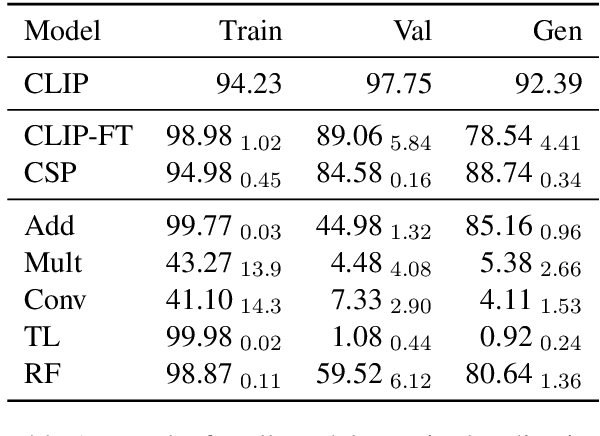
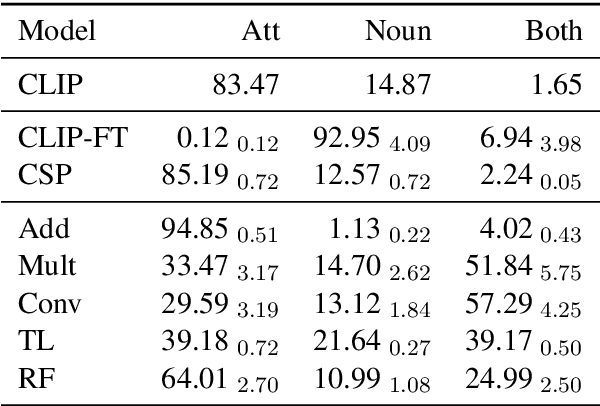
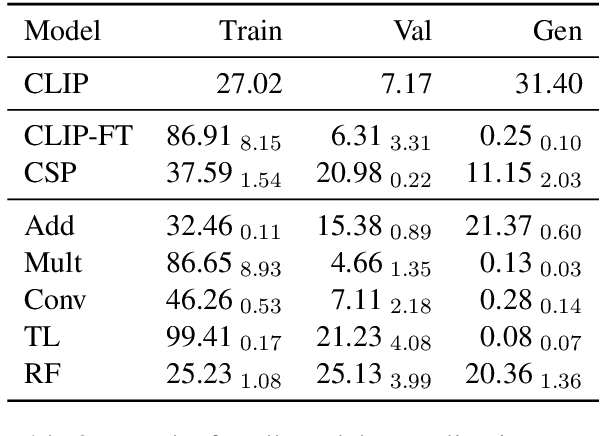
Abstract:Large-scale models combining text and images have made incredible progress in recent years. However, they can still fail at tasks requiring compositional knowledge, such as correctly picking out a red cube from a picture of multiple shapes. We examine the ability of CLIP (Radford et al., 2021), to caption images requiring compositional knowledge. We implement five compositional language models to probe the kinds of structure that CLIP may be using, and develop a novel training algorithm, Compositional Skipgram for Images (CoSI), to train these models. We look at performance in attribute-based tasks, requiring the identification of a particular combination of attribute and object (such as "red cube"), and in relational settings, where the spatial relation between two shapes (such as "cube behind sphere") must be identified. We find that in some conditions, CLIP is able to learn attribute-object labellings, and to generalize to unseen attribute-object combinations. However, we also see evidence that CLIP is not able to bind features together reliably. Moreover, CLIP is not able to reliably learn relations between objects, whereas some compositional models are able to learn these perfectly. Of the five models we developed, none were able to generalize to unseen relations.
ezCoref: Towards Unifying Annotation Guidelines for Coreference Resolution
Oct 13, 2022
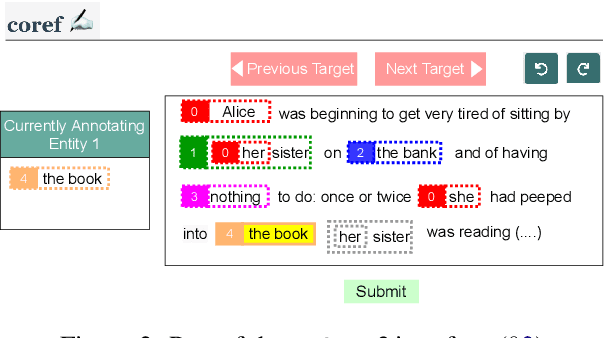

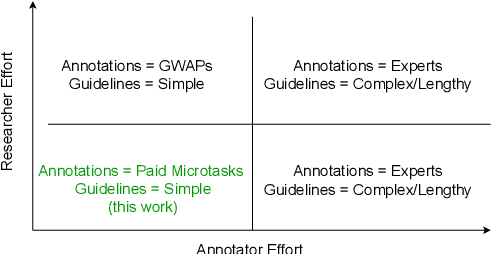
Abstract:Large-scale, high-quality corpora are critical for advancing research in coreference resolution. However, existing datasets vary in their definition of coreferences and have been collected via complex and lengthy guidelines that are curated for linguistic experts. These concerns have sparked a growing interest among researchers to curate a unified set of guidelines suitable for annotators with various backgrounds. In this work, we develop a crowdsourcing-friendly coreference annotation methodology, ezCoref, consisting of an annotation tool and an interactive tutorial. We use ezCoref to re-annotate 240 passages from seven existing English coreference datasets (spanning fiction, news, and multiple other domains) while teaching annotators only cases that are treated similarly across these datasets. Surprisingly, we find that reasonable quality annotations were already achievable (>90% agreement between the crowd and expert annotations) even without extensive training. On carefully analyzing the remaining disagreements, we identify the presence of linguistic cases that our annotators unanimously agree upon but lack unified treatments (e.g., generic pronouns, appositives) in existing datasets. We propose the research community should revisit these phenomena when curating future unified annotation guidelines.
 Add to Chrome
Add to Chrome Add to Firefox
Add to Firefox Add to Edge
Add to Edge